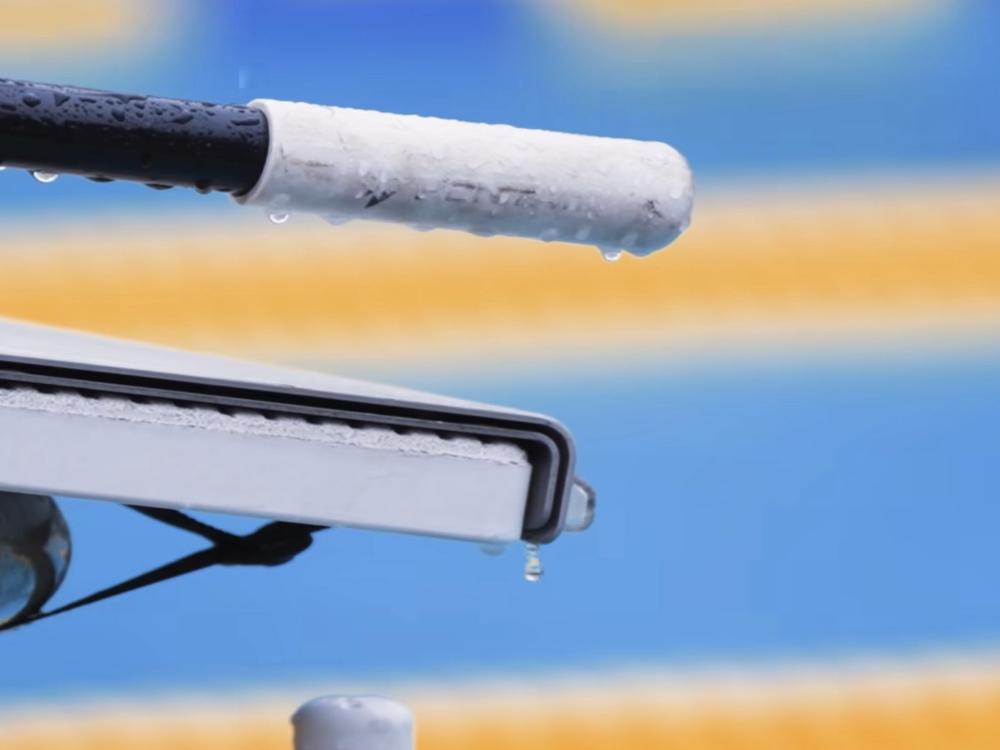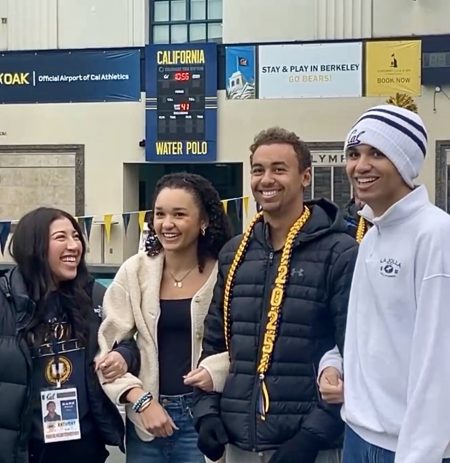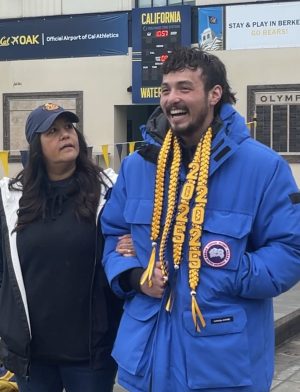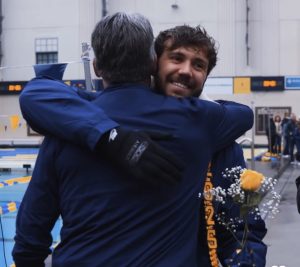Q&A with ESPN: Is NCAA Swimming Ready for Its Next Wave?

NCAA Swimming Has a Chance to Emerge From Turbulent Waters in Stronger Position

Rose is All Smiles
BERKELEY, Calif. — The sky hung heavy with gray clouds over Spieker Aquatics Complex, a fitting backdrop for the Cal Men’s Swimming Senior Day, in which the Golden Bears hosted Stanford in the storied Big Splash. While the weather hinted at turbulence above, a more pressing conversation was brewing on deck.
ESPN+ Broadcaster Billy Miller sat down with Swimming World Publisher/CEO Jack Hallahan, a Villanova and NYAC Swimming alum with a sports publishing background at Sports Illustrated and Men’s Health. Their discussion explored the effects of NIL and conference re-alignments on team rosters, changes brought on by the transfer portal, evolving fan engagement, and the pros and cons of international athletes in the NCAA.
“The NCAA has always been the backbone of USA Olympic swimming,” Hallahan began, reflecting on how the collegiate system has historically fueled America’s Olympic dominance. “But with NIL, transfers midseason, and potential roster cuts, we’re at a crossroads. The question is, how do we not just survive this shift—but grow?”

Lucas Henveaux flashes “W” after pool record 1650 Free
Roster turnover, once an offseason storyline, now unfolds during the campaign, disrupting team chemistry and long-term development plans. Transfers and conference re-alignment have created an evolving landscape, offering athletes newfound autonomy while coaches face uncertainty. These new rules of engagement will challenge how USA Swimming approaches team development and structure. Highlighting the stark contrast with international systems, Hallahan stated:
“Look at Australia—if you’re an Olympic hopeful there, you’re likely centralized to (the Gold Coast) or (Brisbane). You’re with the national program (of sorts) for four years. In the U.S., we rely on talented NCAA coaches like Bob Bowman, Anthony Nesty, and Dave Durden developing athletes across 3,000 miles in diverse programs. Is this better being centralized like Australia, China, Great Britain?
This is a question for USA Swimming’s soon-to-be-announced new leadership to contemplate. NCAA swimming’s strength lies in its diversity and innovation. Different coaching styles, training environments, and competition levels. Having international swimmers in your program shows each swimmer where the bar is set. As Cal coach and Hall of Famer David Marsh often remarks, “iron sharpens iron.” To maintain that edge, we need stronger alignment with USA Swimming and a clearer vision for how collegiate programs fit into the national pipeline.”
The Entertainment Factor
“Here’s the good news: Swimming has been there. The ISL brought energy—light shows, DJs, excitement. The idea was spot on,” said Hallahan. “We just need to activate new ideas to spark interest. Nebraska Volleyball drew 92,000 fans for a women’s match. Swimming, diving, or water polo do that! We did it for Olympic Trials with a pool on the Colts’ 50-yard line—25,000 fans showed up each night. The key is creating experiences, not just competitions.”
Kyle Sockwell, with his Blue Jean Races, and events like Akron-Duquesne’s Mystery Meet—where swimmers don’t know their event until moments before racing—new formats can generate thrilling, high-energy environments. “It’s more than fast times and pool records,” Hallahan said. “Make swim meets fun, make them memorable—or interactive…that’s how you grow a fan base.”
He’s pushing bold ideas: live relays or diving during college football halftimes, pop-up pools in places like Times Square or Wrigley Field, even outdoor meets before MLB or WNBA games. But it’s more than a swimming spectacle—it’s about stakes. “Fans love high stakes! Imagine if Cal vs. Stanford’s Big Splash impacted NCAA seeding. Give every race meaning, and people will really get into it.
“It’s not just about the race—it’s about the surprise,” Hallahan noted. “Take the Mystery Meet between Akron and Duquesne, where swimmers don’t know what event they’re racing until moments before stepping onto the blocks. This unique format pushes athletes to adapt on the fly, adding suspense for both competitors and spectators. In real time! Each race creates an electric atmosphere. Same can be done for diving or water polo. Experiment. Innovate. Bring new energy and attract new fans.”
The International Influence: A Double-Edged Sword?
As swimmers from around the world prepared to race, Miller posed a critical question: “Are we giving away medals by training the world’s best right here in the NCAA? Take Cal Freshman Yamato Okadome who dedicated his training to this program in hopes of achieving global success for Japan?”
Hallahan didn’t hesitate. “No. That’s a false narrative. International athletes make U.S. swimmers better. Period. Sweden’s Bjorn Seeliger, Belgium’s Lucas Henveaux, Yamato Okadome—they’re not taking spots; they’re raising the bar. When you race against the best, you become the best.”
He emphasized that international diversity isn’t diluting American dominance; it’s enhancing it. “Fast swimming doesn’t happen in a vacuum. It thrives in competitive ecosystems. The fact that the NCAA attracts top talent globally is a strength, not a weakness.”

Cal Freshman Yamato Okadome vs Stanford’s Ron Polonsky
Miller added: “That’s true! We saw it last year—ASU came into a rainy dual meet at Cal and together these squads broke 13 pool records. Thirteen. That’s not a fluke. This happens when you bring the best athletes together.”
The Path Forward: LA 2028 and Beyond
“Between now and LA28, USA Swimming will have new leadership. A new CEO, a new National Team Director—with a big agenda,” Hallahan said. “The Olympics on home soil is a rare opportunity to redefine our sport’s trajectory.”

Senior Destin Lasco’s Happy Place
He envisions a future where NCAA swimming isn’t just an Olympics feeder system but a major entertainment product in its own right. “ESPN+ is onto something by broadcasting these meets. Imagine if dual meets were broadcast like college basketball, with dedicated commentators, live stats and scoring, even real-time betting lines. Why not? The talent is there. The excitement is there. We just need to package it.”
Hallahan also stressed the importance of advocacy. “What Executive Director Samantha Barany and the College Swimming Coaches Association are doing—lobbying on Capitol Hill, engaging with athletic directors—is crucial. She is fighting against new NCAA rules that could limit the number of swimmers on college teams, making it harder for young athletes to compete. We need to protect and expand collegiate programs, not just for medals but for the health of the sport.”
Final Lap
With 400 free relays underway, the energy around the pool surged—cheers echoing, swimmers lining the deck, and coaches shouting splits. Proud families gathered to send their seniors off with a bang! It was a reminder of what makes swimming special: a pure, raw, unfiltered pursuit of excellence.
One thing was clear as we celebrated medalists and finalists from the Paris Games and the World Championships in Budapest at a rainy dual meet in Berkeley, California: NCAA swimming is the Olympic proving ground, where the best of the best rise to the surface.“LA 2028 isn’t just another Olympics,” Hallahan concluded. “It’s a chance to redefine who we are as a sport. The turbulence is real—but so is the opportunity.”
The NCAA is evolving. The global landscape is shifting. The next generation of athletes is watching.
Quiet, please…Swimmers…Step Up…

Final Lap at Spieker for Jack Alexy

Destin Lasco laughs at Bjorn Seeliger comment

Team Alexy

Cal’s Dave Durden having a “Senior” moment




And the thinking seems to be that the very best way to prepare for international long course swimming seems to be that we should emphasize SC Yards swimming despite the large number of long course pools now available.?
In 1988 I brought forth the idea of a USA vs. ASU (Arizona ) dual meet (post Seoul games Sept) in a temp pool (Paddock pool was interested) put in the middle of Sun Devil stadium for 5 sport event 2.5 hrs.long, women’s Volleyball match (had 10,000 for in season event), Few track events, few gymnastic events, and I think wrestling. These events would have been spaced out, going from a swim event to Floor routine, sprint hurdles, etc. Swimming had a few events where we had 2,000 in attendance. Goal was to showcase Olympians USA, plus ASU had athletes (foreign in Seoul) and attract a folks who loved & appreciated Olympic sports. Let’s continue to think outside the box -look at the # for these sports when promoted.
Love it! Think outside the box. Have a multi-event day/weekend where track, swimming, volleyball all contribute points towards the winning school! Who’s ready to make that happen? Texas? Michigan? Cal? UVA? Stanford? They all have campuses that would easily facilitate!